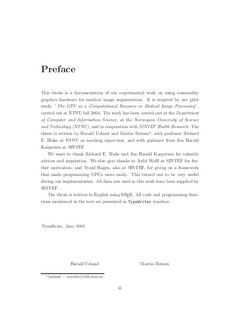Using Commodity Graphics Hardware for Medical Image Segmentation
Master thesis
Permanent lenke
http://hdl.handle.net/11250/250916Utgivelsesdato
2005Metadata
Vis full innførselSamlinger
Sammendrag
Modern graphics processing units (GPUs) have evolved into high-performance processors with fully programmable vertex and fragment stages. As their functionality and performance are still increasing, more programmers are appealed by their computational power. This has led to an extensive usage of the GPU as a computational resource in general-purpose computing, and not just within applications of the entertainment business and computer games. Large volume data sets are involved when it comes to medical image segmentation. It is a time consuming task, but is important in the process of detection and identification of special structures and objects. In this thesis we investigate the possibility of using commodity graphics hardware for medical image segmentation. By using a high-level shading language, and utilizing state of the art technolgy like the framebuffer object (FBO) extension and a modern programmable GPU, we perform seeded region growing (SRG) on medical volume data. We also implement two pre-processing filters on the GPU; a median filter and a nonlinear anisotropic diffusion filter, along with a volume visualizer that renders volume data. In our work, we managed to port the Seeded Region Growing (SRG) algorithm from the CPU programming model onto the GPU programming model. The GPU implementation was successful, but we did not, however, get the desired reduction in time consume. In comparison with an equivalent CPU implementation, we found that the GPU version is outperformed. This is most likely due to the overhead associated with the setup of shaders and render-targets (FBO) while running the SRG. The algorithm has low computational costs, and if a more complex and sophisticated method is implemented on the GPU, the computational capacity and the parallelism of the of the GPU may be more utilized. Hence, a speed-up in computational time is then more likely to occur compared to a CPU implementation. Our work involving a 3D nonlinear anisotropic diffusion filter strongly suggests this.
